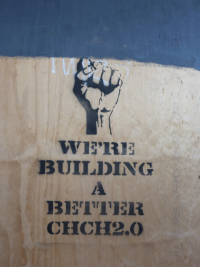
Launched at the end of 2019 after extensive consultation with arts communities across the city, Toi Ōtautahi A Strategy for Arts and Creativity in Ōtautahi Christchurch sets out four Pou Arahi: Key Themes for Development and Ngā Hohenga: Strategic Action Areas that will move us towards the desired outcomes of each of the Christchurch City Council’s strategy pillars for the arts. Crucially, Toi Ōtautahi creates—for the first time since 2001—a framework for the development of arts policy, funding, and activity at a local government level.
It will take time for this strategy to become embedded within operations, and at this point implementation requires deeper understanding of the sector. One of the key strategic areas is resourcing; ensuring transparency and clarity of processes for accessing funds and resources so that the arts and artists thrive. In response to this, the Council’s arts team developed a survey to map and identify city-wide creative economic activity. Our survey received 337 responses and was filled out between January and February 2021. The survey follows on from Creative New Zealand’s national survey of artists (1447 respondents) in 2019.
The broad picture across both surveys is that creative practitioners are, on the whole, struggling to make a living. 59% and 77% respondents, in the CNZ and CCC survey respectively, said they were unable to make a living off their art. This is not news: Artbeat reported on the results of the CNZ survey last year. However, following the results Creative New Zealand released guidelines around payment for creatives, recommending a $25 per hour minimum for creative work in any funding applications.
Concerns around the ongoing effects of COVID were strongly reflected in our survey with over 40% of respondents reporting decreased turnover throughout 2020, and over 50% stating their creative businesses suffered during COVID, as compared to 13% who experienced a positive impact. More promising in relation to the inability to travel was a focus on local and regional markets with 65% of respondents working and producing work for these audiences.
The Ministry of Culture and Heritage is also due to launch their Creative Arts Recovery and Employment Fund in the coming month, which aims to stimulate arts activity in under-served areas. In terms of opportunities, larger arts organisations are embracing local and national programming with increasingly home-grown line-ups.
Asked which areas of their career they required help with, respondents identified marketing and advice on grant and funding applications. This is indicative of a lack of accessible and relevant professional development opportunities post-tertiary study and is something that the government’s recent announcement concerning the re-introduction of Pathways to Arts and Cultural Employment scheme (now called Careers Support for Creative Practitioners) seeks to address. Pilot programmes are currently being rolled out in Auckland, Waikato, and Nelson. This is also an area that the Council Arts team is investigating, with planned Hui and workshops for artists and arts organisations to improve their knowledge around professional practices.
Accessing increased funding and support from local and central government requires buy-in from elected officials, which requires the gathering of evidence and support. As we work to implement Toi Ōtautahi there are ongoing opportunities to contribute to this discussion: the Christchurch City Council’s draft Long Term Plan is now available to read and submit feedback on and I encourage you to submit a response.
(Note: the Hui for practitioners from the East did not go ahead on March 3; this will take place at a later date. To attend, please register your interest with artsadvisors@ccc.govt.nz. This address can also be used if you have any questions about the Long Term Plan and how to submit.)
IMAGE
Ōtautahi Street art stencil : "We’re building a better Christchurch 2.0”
